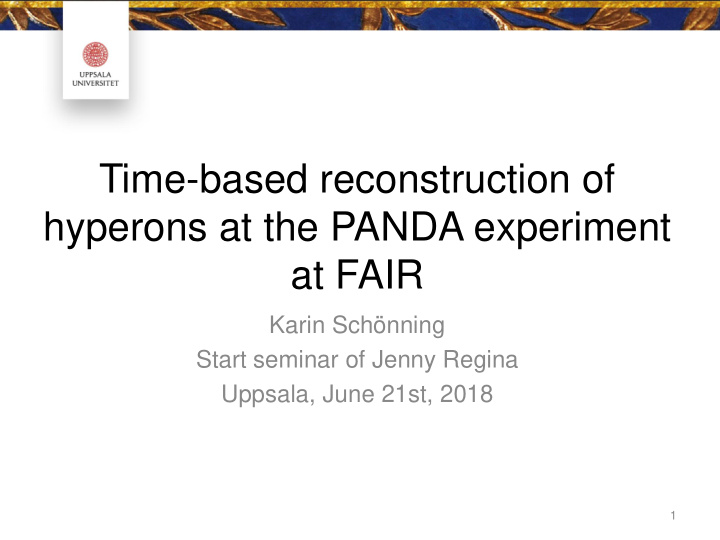



Time-based reconstruction of hyperons at the PANDA experiment at FAIR Karin Schönning Start seminar of Jenny Regina Uppsala, June 21st, 2018 1
Outline • Prologue • Why hyperons? • Hyperon physics with PANDA • Challenges with hyperons • PANDA@HADES • Summary and outlook 2
Prologue Missing in the Standard Model of particle physics: A complete understanding of the strong interaction. • Short distances / high energies: pQCD rigorously and successfully tested. • Charm scale and below: pQCD fails, no analytical solution possible.
Prologue Many fundamental puzzles manifest in the nucleon: • Discovered a century ago. • Still, we don’t understand – Its abundance – Its mass – Its spin – It radius – Its inner structure 4
Prologue Abundance : matter-antimatter / nucleon-antinucleon asymmetry of the Universe. Equal amounts in Big Bang (?) → Where did the anti -nucleons go? Baryogenesis*: possible if - Baryon number violation - CP violation - Processes outside thermal equilibrium. Picture from Virginia Tech 5 *A. D. Sakharov, JETP 5 (1967) 24-27
Prologue Mass: • Summing quark masses: 1% of total proton mass. → 99% of the visible mass in the Universe is dynamically generated by the strong interaction! But how? 6
Prologue Spin: • Valence quark spin only cause ~1/2 of the total nucleon spin*. • Proposed solution to spin crisis: – Sea quarks? – Gluons? – Relative angular momentum? 7 *C. A. Aidala et al., RMP 85 (2013) 655-691.
Prologue Radius: measured in – Electron-nucleon scattering – Electronic hydrogen spectrum – Muonic hydrogen spectrum. Results disagree.* Inner structure: – Neutron charge distribution intruguing.** *R. Pohl, Nature 466 (2010)7303, 213-216. 8 ** G. A. Miller, PRL 99 (2007) 112001.
Approaches When you don’t understand a system, you can* – Scatter on it – Excite it – Replace one of the building blocks 9 *C. Granados et al., EPJA 53 (2017) 117
Why hyperons? What happens if we replace one of the light quarks in the proton with one - or many - heavier quark(s)? Λ Σ 0 Ξ - Ω - 10 proton
Why hyperons? • Systems with strangeness – Scale: m s ≈ 100 MeV ~ Λ QCD ≈ 200 MeV. – Relevant degrees of freedom? – Probes QCD in the confinement domain. • Systems with charm – Scale: m c ≈ 1300 MeV. – Quarks and gluons more relevant. – Probes QCD just below pQCD. 11
Why hyperons? Traceable spin: Polarization experimentally accessible by the weak, parity violating decay: Example: Angular distribution of Λ→ p π - decay I (cos θ p ) = N(1+ α P Λ cos θ p ) P Λ : polarisation α = 0.64 asymmetry parameter 12
Hyperon Physics with PANDA PANDA Topic Key questions Hyperon production Nucleon mass Hyperon Nucleon spin spectroscopy Hyperons as Nucleon structure diagnostic tool Hyperon structure Matter-antimatter asymmetry Hyperon decays
𝑞𝑞 annihilations Hyperon production in ҧ • Mainly single-strange data. • Scarce data bank above 4 GeV. • No data on Ω or Λ 𝑑 . T. Johansson, AIP Conf. Proc. of LEAP 2003, p. 95.
ҧ Hyperon production. Spin observables sensitive to the interaction process. • Prediction for 𝑓 + 𝑓 − → ത 𝑍𝑍 based on potential models obtained 𝑞𝑞 → ത 𝑍𝑍 data.* with • New data from BESIII on hyperon structure.** → Understanding ത 𝑍𝑍 interaction *PLB 761(2016) 456 important! BaBar: PRD 76 (2007) 092006 ***BES III: Talk by C. Li, BEACH2018
The PANDA experiment at FAIR Facility for Antiproton and Ion Research 16
The PANDA experiment at FAIR The High Energy Storage Ring (HESR) • Anti-protons within 1.5 GeV/c < p pbar < 15 GeV/c • Internal targets – Cluster jet and pellet ( ҧ 𝑞𝑞 ) – Foils ( ҧ 𝑞𝐵 ) 17
The PANDA experiment at FAIR • Modulatr design • 4 π coverage • Vertex detector • Modular design • Precise tracking • Time-based data acquisition • PID with software trigger • Calorimetry 18
Online reconstruction and filtering PANDA will use an entirely software-based data selection!
Online reconstruction and filtering Algorithms will depend on event topology
Challenges in hyperon reconstruction Weak decays → displaced vertices – Tracks do not come from the interaction point. – Hyperons may miss fast detectors. – Complicated event topology.
Challenges in hyperon reconstruction Need a data selection scheme compatible with the complex hyperon topology – Independent of track origin. – Dynamic event and track reconstruction. – Paradigm changing event filter concept. – Which detectors are the key players?
PANDA @ HADES New Memorandum of Understanding between PANDA and HADES! • Possible to test tools and methods on real data! • Possible to do hyperon physics in Europe before PANDA@FAIR! 23
Interesting questions for HADES/PANDA • Electromagnetic transitions of octet- and decuplet hyperons – 𝑍 𝐵 → 𝑍 𝐶 𝛿 (mainly 𝛿Λ quasi-final states) 𝐶 𝑓 + 𝑓 − (mainly 𝑓 + 𝑓 − Λ quasi-final states) – 𝑍 𝐵 → 𝑍 – 𝑍 𝐵 → 𝑍 𝐶 𝛿π 24
Summary • Many fundamental questions manifest themselves in our (lack of) understanding of the nucleon. • Strategy: replace one of the building blocks → hyperons! • Hyperons of different flavour probe different scales of the strong interaction. • Self-analyzing decay → help pinpointing the role of spin. 25
Outlook • Collecting and reconstructing hyperon events is a challenging task! • Need detailed knowledge of hyperon signals in the PANDA detector. • Need a track reconstruction method that – Can be used online. – Is independent of the interaction point. • PANDA@HADES opens up new possibilities: – Test tools and methods developed for PANDA – Do interesting hyperon physics before PANDA@FAIR. 26
Thanks for your attention! 27
Recommend
More recommend